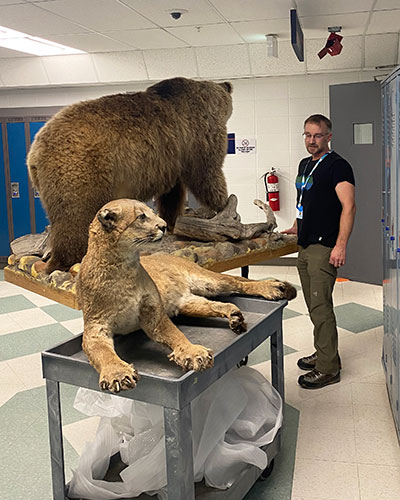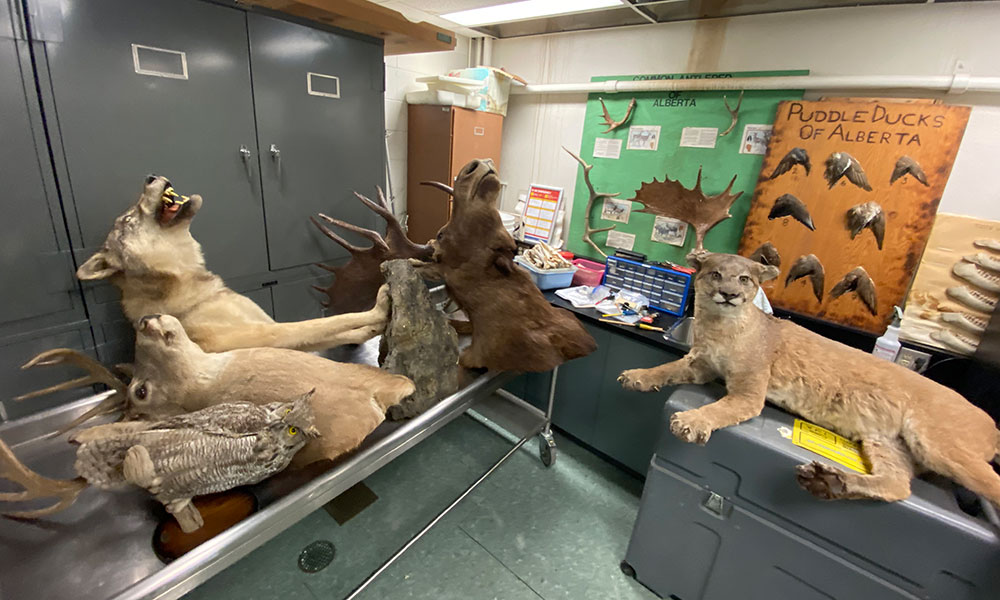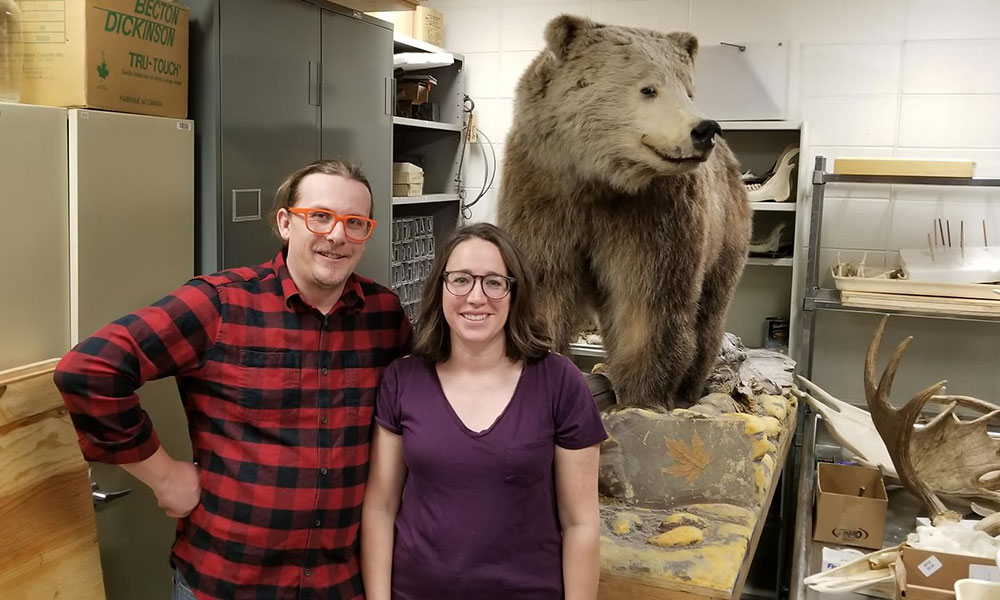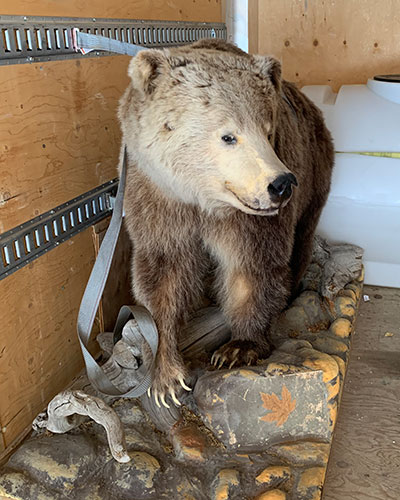Collection will help prepare “leaders for the future”
In October, NAIT became home to nine animals that might be considered rescues.
Making up the menagerie is a grizzly bear, cougar, black bear, yak, owl, hawk, deer, moose and a wolf. Currently, they coexist in a room in the basement of Main Campus, peacefully and quietly because, well, they’re not alive. They haven’t been for years.
The taxidermy is a gift from Goldeye Centre. For 65 years, the facility has hosted summer camps and offered outdoor activities and education in the Rockies near the town of Nordegg. Since the early ’80s it’s also been the base for field training for Conservation Biology students.
But in December 2022, Goldeye temporarily shut its doors to address infrastructure issues such as shallow sewer lines and asbestos abatement. But the closure also gave its live-in operators, Lanny Anderson and Cyrena Quinn (with their two young daughters), the chance to return the facility to its origins as an authentic nature retreat, a status that had been eroded by a focus on events.
In the process, they realized that the stuffed animals, perhaps ironically, no longer had a place at Goldeye, where they gathered dust as dining room decorations.
“They were seen more as interior design furnishings to create a cabin-y, rustic experience rather than what they were intended to be,” says Anderson, “which is an educational piece.”
Fundamentals in feathers and fur
 For Dave Critchley (Biological Sciences Technology – Renewable Resources ’98, Forest Technology ’99), the gift is invaluable in supporting hands-on instruction in Conservation Biology, which he chairs.
For Dave Critchley (Biological Sciences Technology – Renewable Resources ’98, Forest Technology ’99), the gift is invaluable in supporting hands-on instruction in Conservation Biology, which he chairs.
It enhances the program’s existing collection of preserved bones, insects, plant material and more that familiarizes students with aspects of careers to come.
“If they’re going to manage the landscape, our graduates will need this foundation,” says Critchley. “How do you manage anything if you don’t have those fundamentals?”
The Goldeye collection is unique for making some of Alberta’s most elusive species accessible.
Joined in the basement one afternoon by Anderson and Quinn to show off the newly arrived collection, Critchley points to the grizzly bear. It’s about four feet tall and six feet long.
“How many people can walk up and inspect this fur and claws without being mauled?” he asks. “You’re not going to be tickling this bear out in the wild.”
But getting to know these animals safely at close range leaves a lasting impression.
“Could you remember a photograph better than you could remember touching an actual physical [specimen]?” asks Critchley. “I could not.”

The animals embody opportunities for closer examination, too. Previously, Critchley has partnered with Nanosystems Engineering Technology to produce images of the finest features of hair and feathers using a scanning electron microscope. He’ll do the same with samples from the Goldeye collection, showing students’ how to identify animals from traces left in an ecosystem or a poacher’s vehicle.
“We’re producing leaders for the future,” says Critchley. He feels that such tactile experience – running a hand over coarse fur, studying the size and shape of a cougar’s paw, or examining the nanometric topography of an owl’s feather – elevates the quality and practicality of the program.
“When those students graduate, they’re doing things on the job – on day one – that they already did with us.”
A delicate conversation

Critchley knows “a delicate conversation” underlies the transfer of the animals from Goldeye to NAIT. They were, after all, once alive (most were preserved decades ago, according to permits accompanying them). Some, like the gray wolf, are keystone species that helped shape their ecosystems; today, the grizzly bear is “at risk” in Alberta.
“We don’t want to have these mishandled,” Critchley says. “We don’t want to have them represented in a distasteful manner.”
For the time being, the collection will be accessed mainly by biological sciences students. But Critchley dreams of it one day being safely displayed somewhere on campus with other program specimens to inform and inspire students from across NAIT.
“This is a resource for Alberta and Canada,” he says.
 The managers of Goldeye would like that, too.
The managers of Goldeye would like that, too.
When Quinn first walked into the basement room, her throat tightened with emotion. She’d missed seeing the animals. But it also struck her that they were where they belonged.
“It was almost selfish of us,” she says. “We were holding onto something because it was historical and sentimental, when we could be giving it to someone who could use it well.”
As she and Anderson work toward what they refer to as Goldeye 2.0, and continue fundraising to pay for upgrades, their gift is poised to give back to them.
In time, they’ll again provide experiences that connect people to nature. For now, they’ll look to long-time friends to help.
“If NAIT can use this to do that,” says Quinn, gesturing to the collection around her, “then we’re fulfilling our goal outside of our own facility.”
Banner image: Educational laboratory technologist Eric Lastiwka brings the collection of taxidermy animals to NAIT from the Goldeye Centre